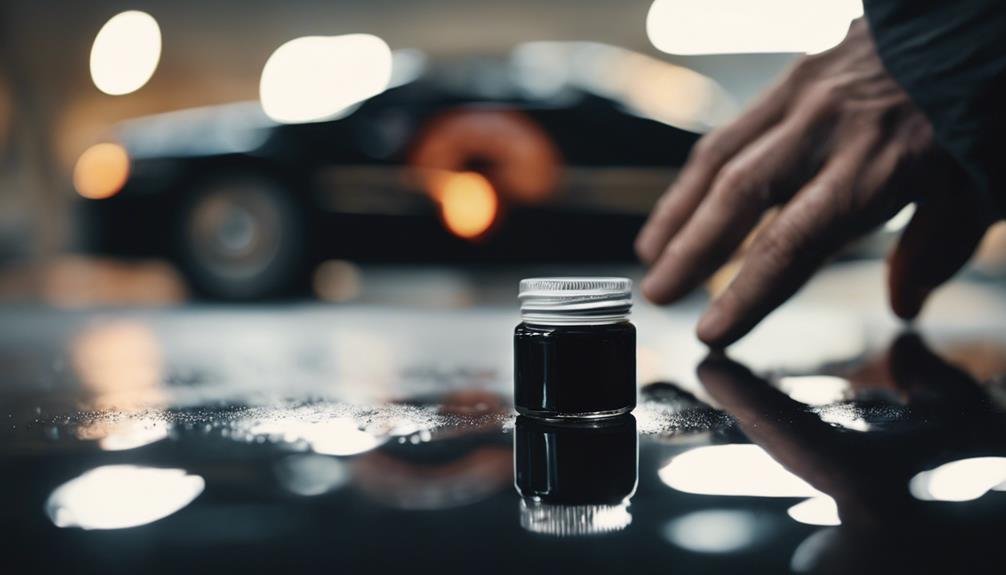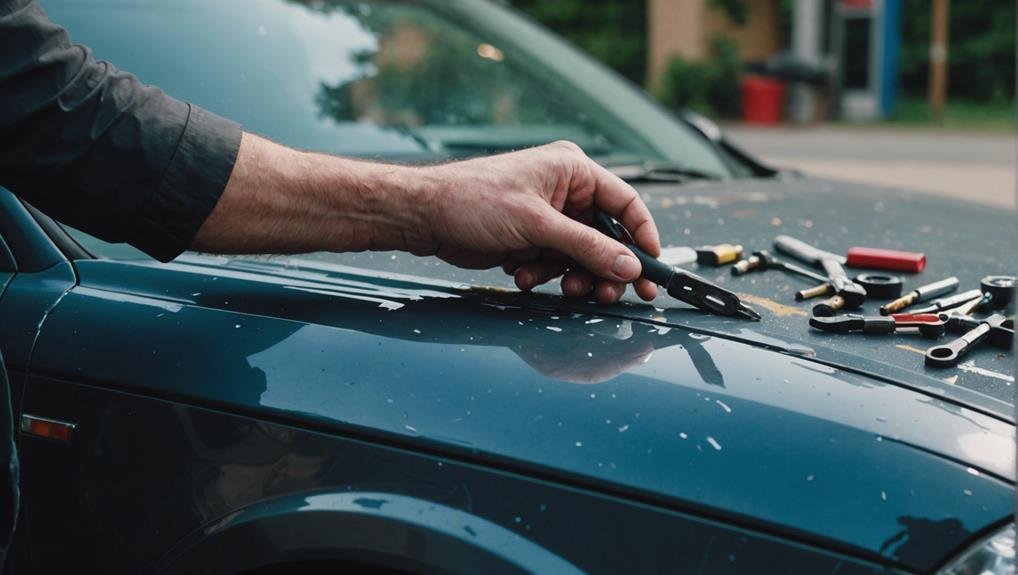When you notice deep scratches on your car's surface, address them promptly to prevent rust formation and further damage. Assess the scratch by running your fingernail over it to determine its depth and severity. Clean and dry the area, then fill the scratch with glazing putty, spreading it evenly and allowing it to cure. Apply touch-up paint, matching the original color, in thin, even coats, allowing each coat to dry completely. To conclude, buff and polish the area using a car scratch repair kit to achieve a smooth, seamless finish. Following this, you can investigate more detailed repair methods and prevention strategies to maintain your car's showroom shine.
Key Takeaways
- Assess the scratch by running your fingernail over it to determine its depth and severity, and evaluate rough edges and uneven surfaces.
- Thoroughly wash and dry the affected area, then clean it with rubbing alcohol before filling deep scratches with glazing putty.
- Apply glazing putty evenly to create a smooth surface, and use a paint leveler to remove excess putty and achieve a uniform surface.
- Apply high-quality touch-up paint that matches the original color, using thin, even coats and allowing each coat to dry completely.
- Use a car scratch repair kit to buff and polish the area, applying polishing compound in circular motions to smooth out rough edges.
Assessing the Scratch Damage
When you run your fingernail over the scratch, you'll be able to determine the depth and severity of the damage, which is vital in deciding the best course of repair.
Evaluating scratch damage is critical, as deep scratches can penetrate through the clear coat, base coat, and even reach the primer layer, exposing the metal underneath. If left unchecked, this can lead to rust formation, which can spread quickly and cause further damage.
To evaluate deep scratches, you need to determine the depth and severity of the damage. This involves running your fingernail over the scratch to feel for any rough edges or uneven surfaces. By doing so, you'll be able to determine if the scratch has reached the primer layer or metal underneath.
Proper evaluation of deep scratches is necessary to determine the appropriate repair method and prevent further damage.
Preparing the Repair Area
Now that you've evaluated the scratch damage, it's time to prepare the repair area by thoroughly washing and drying the affected area to remove dirt and debris that can interfere with the repair process. This step is vital to guarantee a successful and long-lasting fix for deep scratches on your car.
To prepare the repair area, follow these steps:
- Clean the area around the scratch with rubbing alcohol to remove any dirt or grime that may impact the repair process.
- Inspect the scratch closely to determine the depth and extent of the damage before proceeding with repairs.
- Make sure the area is completely dry before filling deep cracks with glazing putty to create a smooth surface for painting.
- Apply a small amount of glazing putty to the scratch, spreading it evenly to fill the damaged area.
Filling Deep Scratches

You'll fill deep scratches by applying glazing putty to the affected area, which creates a smooth surface for paint application.
Before applying the putty, clean the area with rubbing alcohol to guarantee better adhesion and results.
Next, use a spreader tool to spread the putty evenly over the scratch, making sure to fill it completely.
After applying the putty, use a paint leveler to remove excess putty and achieve a uniform surface.
It's vital to allow the putty to cure and solidify quickly before proceeding with touch-up paint application. This step is critical in filling deep scratches, as it provides a smooth surface for painting.
By following these steps, you'll be able to successfully fill deep scratches and prepare the area for touch-up paint.
Remember, proper adhesion and a smooth surface are key to a successful repair.
Applying Touch-Up Paint
With your car's surface properly prepared and filled, apply touch-up paint to the repaired area, making sure to match the original color as closely as possible to achieve a seamless blend. Applying touch-up paint requires precision and patience to achieve a professional-looking repair.
Before applying the paint, make sure to clean and prep the area for better adhesion and durability.
Here are some key considerations to keep in mind when applying touch-up paint:
- Use a high-quality touch-up paint that matches your car's original color to guarantee a seamless blend.
- Apply thin, even coats, allowing each coat to dry completely according to the manufacturer's instructions before applying the next one.
- Avoid applying too much paint, as this can lead to unevenness and reduced durability.
- Allow the final coat to dry completely before moving on to the next step, whether it's buffing or polishing.
Buffing and Polishing

Using a car scratch repair kit, you'll tackle the buffing process by applying a polishing compound to the affected area and working it in with tight, circular motions to smooth out the rough edges. This vital step helps eliminate deep scratches, restoring your car's surface to its original state.
With the polishing compound and buffing pads, you'll rub the scratch in small, tight circles, achieving a sanding effect that gradually removes imperfections. As you buff, the rubbing compound helps to smooth out rough edges, ultimately leading to a seamless finish. Be sure to work methodically, applying gentle to moderate pressure, depending on the scratch's severity. By doing so, you'll successfully buff out deep scratches, paving the way for a flawless finish.
After buffing, a final waxing will further improve the appearance of your car, making it look like new again.
Preventing Future Scratches
To safeguard your car's newly restored surface, it's important to take proactive measures to prevent future scratches. By taking a few simple precautions, you can shield your car from potential scratches and maintain its showroom shine.
To prevent future scratches, consider the following:
- Regularly waxing your car provides a protective layer against debris and minor abrasions.
- Parking in a garage or carport shields your car from environmental hazards like tree branches, bird droppings, and direct sunlight, reducing the risk of scratches.
- Hand washing your car or using a touchless wash helps prevent scratches compared to automatic car washes that may cause abrasions from brushes and equipment.
- Using a car cover when your vehicle is parked offers an additional layer of protection, shielding it from dust, dirt, and potential scratches from external elements.
Frequently Asked Questions
Can You Repair Deep Scratches on a Car?
You're wondering if you can repair deep scratches on your car? Yes, you can! With the right techniques, you'll be able to fill, paint, and buff those unsightly scratches away, restoring your car's original shine.
How Much Does It Cost to Repair a Deep Scratch on a Car?
You're wondering how much it'll cost to fix that deep scratch on your car. Well, the price tag can range from $150 to $300, depending on the scratch's severity and the repair method you choose.
How to Remove Deep Scratches From a Car at Home?
You'll start by washing and drying the affected area, then use a car scratch repair kit with glazing putty to fill in deep cracks, and lastly, touch-up paint to match your car's color code.
How Deep of a Scratch Can You Buff Out of a Car?
You can buff out scratches that are shallow to moderately deep, but if they're deep enough to expose the base coat or primer, it's best to seek professional help to avoid further damage.
Conclusion
By following these steps, you've successfully repaired deep scratches on your car.
Remember to regularly wash and wax your vehicle to maintain its appearance and protect the clear coat.
Moreover, consider applying a ceramic coating or paint sealant to provide an extra layer of protection against future scratches.
With proper care, your car's finish will look like new, and you'll be well-equipped to handle any minor scratches that may occur in the future.
